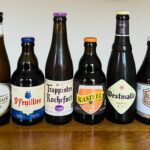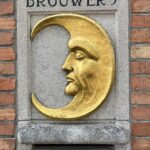A year on from our original battle, we’ve learnt a lot more about beer (and have tried plenty more along the way). And we finally got around to visiting Belgium and doing two brewery tours. But we knew we wouldn’t be able to try all the beers while we were there so we decided to have a few Belgian battles at home before and after our visit to Bruges and Brussels. So here’s a run down of some of our 2024 Belgian beer battles.
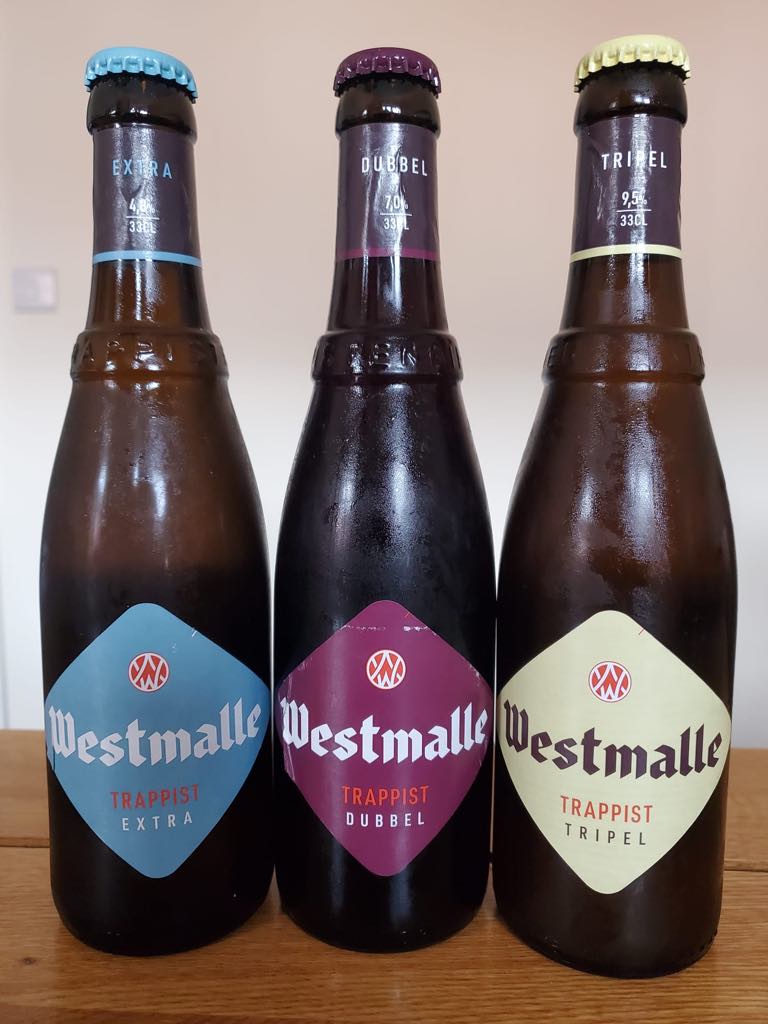
Westmalle
Westmalle is one of the five authentic Trappist breweries in Belgium. We tried their Dubbel and Tripel in some of our 2023 battles, so the Extra was the only new brew, but we wanted to try them together.
Extra (4.8%)
Brewer’s note: This is one of the oldest beers of Westmalle Abbey, with a tradition that dates back to the start of our brewery. It was created to drink with meals in the abbey, something the monks still do today. As a top fermented golden yellow Trappist beer, the Extra is unique in combining a low alcohol content (4.8%) with a rich flavour. Enjoy its fruity notes and its refreshing, thirst-quenching character.
Dubbel (7%)
Brewer’s note: Westmalle Dubbel is a dark, reddish-brown Trappist beer with a secondary fermentation in the bottle. The creamy head has the fragrance of special malt and leaves an attractive lace pattern in the glass. The flavour is rich and complex, herby and fruity with a fresh-bitter finish. It is a balanced quality beer with a soft feel in the mouth and a long, dry aftertaste.
Tripel (9.5%)
Brewer’s note: Was first brewed in 1934 and the recipe has not changed since 1956. It is made with pale candy sugar and has a very pale color produced from a mash of light pilsener malts. Styrian Goldings hops are used along with some German varieties and the classic Saaz pilsener hop. After a long secondary fermentation, the Tripel Westmalle is bottled with a dose of sugar and yeast. This beer holds up well in the bottle over time and seems to soften with age.
Brewer’s website: Trappist Westmalle | Abbey of the Trappists Westmalle
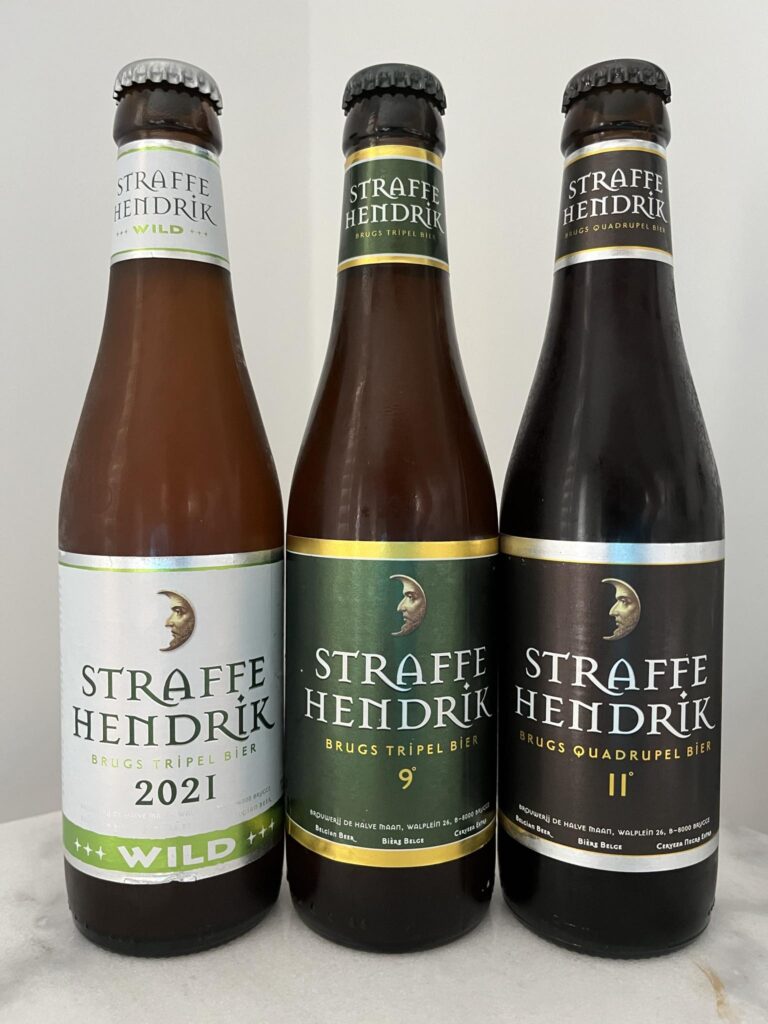
Straffe Hendrik
Brouwerij De Halve Maan is an authentic family brewery in the centre of Bruges. It brews four brands of beer and one of them is Straffe Hendrick. As we had a brewery tour booked, we decided to familiarise ourselves with this range.
We started with the Tripel and followed it up with the Wild which is made using the same recipe before undergoing a refermentation in the bottle. It was interesting to try both so we could understand what the refermentation does to the flavour.
The Tripel had banana aromas that didn’t come through as much in the taste. There was a hint of cloves and a light bitterness on the finish. The Wild was fizzier and funky in flavour.
We finished with the Quadrupel which was our favourite of the three beers. The aroma was similar to the Tripel but it didn’t taste as boozy. It had a velvety mouthfeel and a lovely dried fruit flavour.
Straffe Hendrik Tripel (9%)
Brewer’s note: The beer is strong and full-bodied. The tripel has an alcohol percentage of 9% and the refermentation in the bottle generates a long natural shelf life. Caramel taste flows into bitterness, with the aftertaste comes a subtle hint of banana in combination with citrus fruits.
Straffe Hendrik Wild 10%
Brewer’s note: Our Straffe Hendrik Wild is a wild variant of the well-known Straffe Hendrik Tripel. The beer undergoes a refermentation in the bottle with a wild yeast: the ‘Brettanomyces’ or ‘Brett’ yeast. This gives the beer a longer natural shelf life and ensures a special taste evolution over the years. The beer is only bottled once a year, so there is only a limited supply of each edition available. After three months in the warm room the re-yeasting of the wild yeast is complete, and the young beer is ready to drink. The beer however does keep evolving over the years. The bitter hop aromas are softened, while the wild yeast continues to develop and create fruity and flowery aromas.
Straffe Hendrik Brugs Quadrupel Bier 11° (11%)
Brewer’s note: Straffe Hendrik Quadrupel, launched in 2010, is an intense beer, dark in colour and full in taste.The aroma is elegant, spicy and slightly roasted.The sophisticated blend of special kinds of malt give the beer a complex character, combining a delicate dryness with hints of coriander, dark fruits, anise and roasted chestnuts. The palate finishes in a syrupy taste.The refermentation in the bottle creates a living beer that will evolve over the years.Straffe Hendrik Quadrupel finds an excellent partner in chocolate when it comes to foodpairing.
Brewer’s website: Straffe Hendrik | The art of brewing
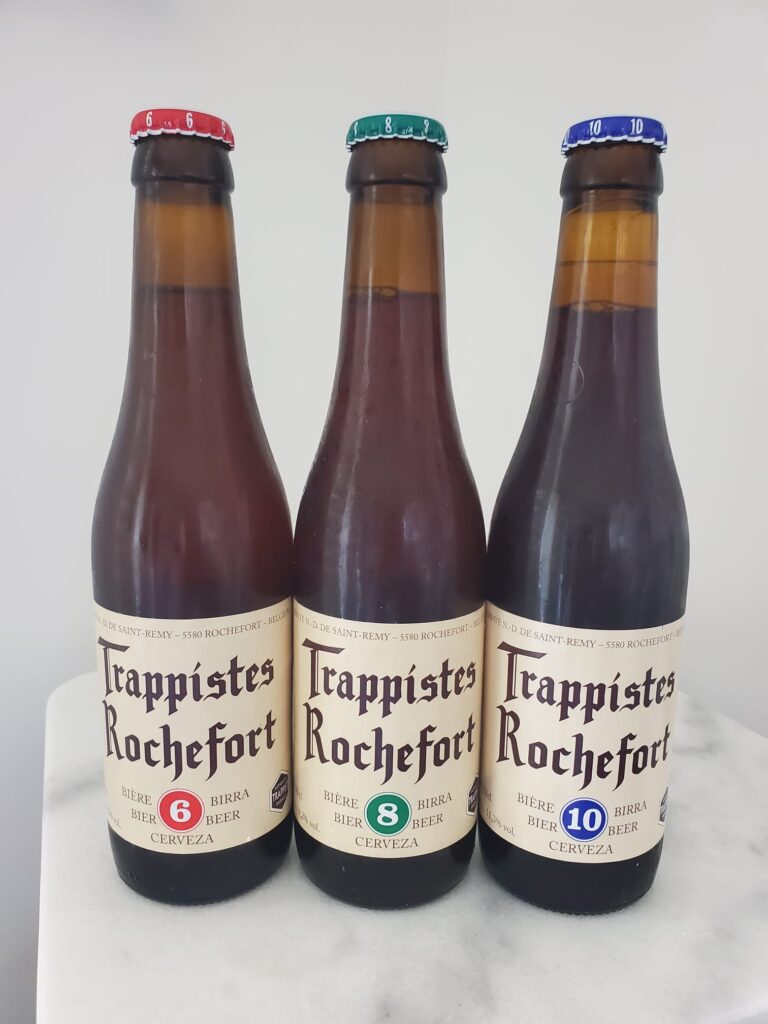
Trappistes Rochefort
Rochefort Brewery is another of the five authentic Trappist Breweries in Belgium and produces four beers that are designated as authentic Trappist beers. The brewery is associated with the Rochefort Abbey, which originated in the 13th century. The current brewery dates from 1899.
We tried three of the four beers – the 6, 8 and 10.
All three beers are made based on the same recipe, which is tweaked slightly for each brew.
We drank them in order of ABV starting with the 6 which smelt amazing. It had notes of toffee that also came through in the flavour. It was fizzy which made it light and very drinkable. It also had a bready taste – almost like a sweet rye bread.
The 8 didn’t have as strong an aroma and wasn’t as fizzy. It had a thicker mouthfeel but wasn’t quite as sweet and the taste lingered much longer. This one was more of a sipper.
The 10 had a similar aroma to the others (not surprising as they have similar recipes), but there was a slight hint of banana. It wasn’t as sweet – more vanilla or dark treacle than toffee. Strong depth of flavour with a warming booziness.
All these beers were excellent. Very hard to pick a favourite as they all had something unique to offer. The 10 was fantastic and it’s clear why it is considered one of the best beers in the world, but the 6 and 8 were also up there with the best beers we’ve ever tried.
Brewer’s website: Trappistes Rochefort
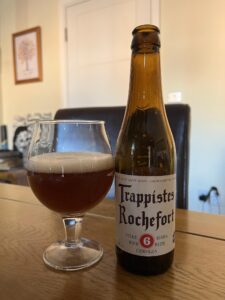
Trappistes Rochefort 6 (7.5%)
Rochefort 6 is the oldest Rochefort Trappist beer and has the lowest ABV of the three.
Brewer’s note: This reddish brown dark Trappist ale features a soft body which leads to earthy flavours and herbal characteristics. A touch of refined soft spiciness is discovered in the bouquet with ints of caramel. Soft, natural carbonation is produced through bottle conditioning.
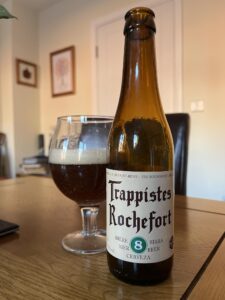
Trappistes Rochefort 8 (9.2%)
Rochefort 8 was originally brewed for New Year’s Eve celebrations, but due to its overwhelming success, the monks decided to brew it regularly (in around 1960). Sometimes this beer is also referred to as the “Special”.
Brewer’s note: This dark Trappist strong ale brings aromas of fresh fruits, spice, leather and figs, sour grapes, sweet port and black liquorice with touches of bread on the palate with dry sultanas, liquorice and brown bread on the finish. Light earthy feel with hints of pepper and cream.
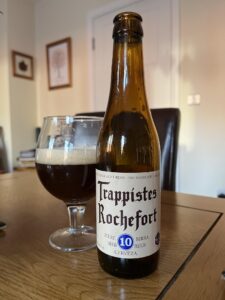
Trappistes Rochefort 10 (11.2%)
Rochefort 10 is the strongest in ABV and according to some people is one of the greatest beers in the world.
Brewer’s note: This strong dark Quadrupel ale brings a rich nose full of figs and plums with hints of bitter chocolate, malt, brandy and caramelised brown sugar. The body brings with it chocolate, plums, cherries and bitter coffee, touches of nutmeg and fresh orange can be felt.
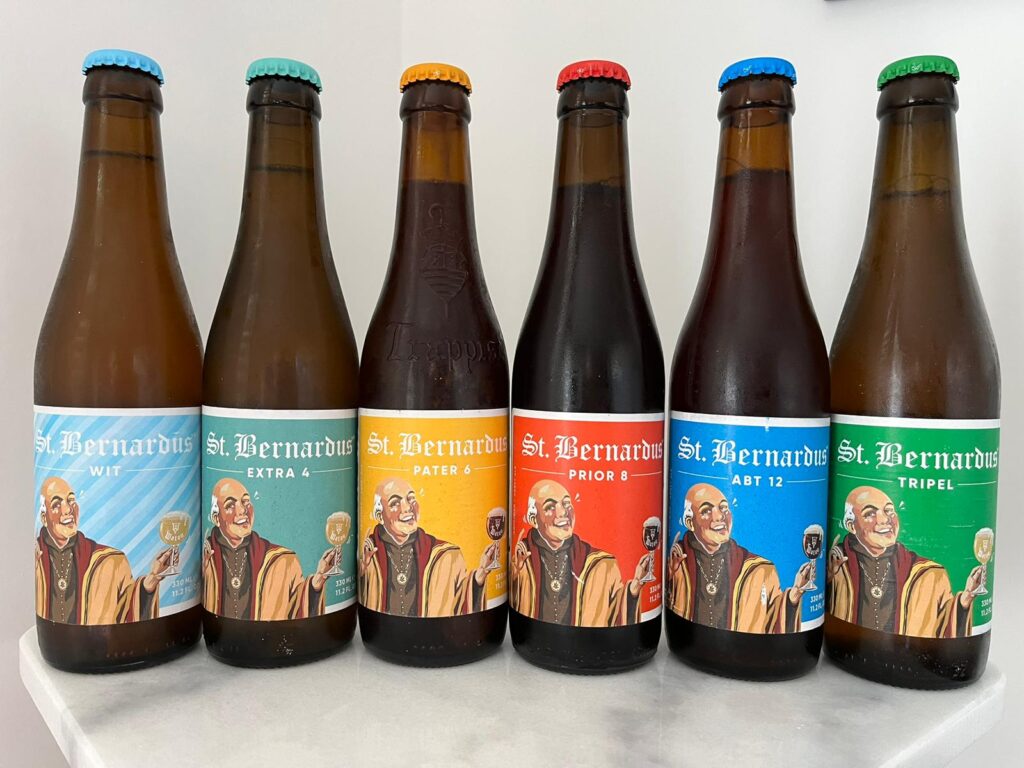
St. Bernardus
The St. Bernardus Brewery has a long history, dating back to 1900, but the St. Bernardus brand has only been around since 1992.
For almost fifty years before that, the brewery produced Trappist beers for Westvleteren Abbey. However, in 1992, the Trappist breweries decided to award the “Authentic Trappist Beer” label exclusively to beers brewed inside an abbey. Since then, the brewery’s beers have been marketed under the St. Bernardus brand name.
During our original Belgian beer battle, the St. Bernardus ABT 12 was one of the standout beers.
We tried it again around Christmas when we battled it against the St. Bernardus Christmas Ale which is based on the same recipe but with a few extra Christmas flavours thrown in. It was just as excellent as we remembered and the Christmas Ale was equally as special (winning our beer of the month for January).
As we’d had such a good experience of St. Bernardus beers, we decided to battle these six.
We started with the light beers – the Wit, the Extra 4 and the Tripel. Then we moved on to the darker Ales – the Pater 6, Prior 8 and (our favourite) ABT 12.
Brewery website: Home | St.Bernardus (sintbernardus.be)
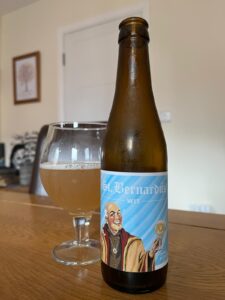
St. Bernardus Wit (5.5%)
This was a good Belgian Wit – one of our favourites. It was light and fizzy with an almost champagne-esque carbonation.
Brewer’s note: St.Bernardus Wit is a traditional unfiltered Belgian wheat beer. It was developed in collaboration with Pierre Celis, the legendary master brewer who was the driver of the resurgence of white beer in the 1960s. St.Bernardus Wit is famed for its zesty tastes of coriander and orange, with background touches of spicy cloves, fragrant with fruit and citrus. These zingy herbs combine with the creaminess of the wheat to produce a beer that is a masterclass in balance. The mild mouth feel produces a lovely interaction between the sweet malty taste and the refreshing touches of acid to produce a feeling of freshness overall
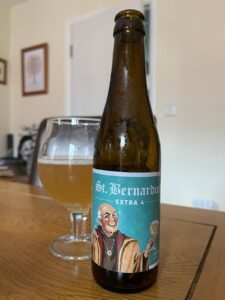
St. Bernardus Extra 4 (4.8%)
This one had more lemon notes than orange with a quicker finish and a little bitterness at the end. Another dry, light beer, We preferred it to the Westmalle Extra.
Brewer’s note: Extra 4 is a refreshing blond beer that is brewed in the classic single style. Every year, our Extra 4 can be enjoyed in spring and summer. If you think that a beer with a lower alcohol percentage will have less powerful flavours then Extra 4 will make you think again. The sweet fragrance of malt is complemented beautifully by a wide range of refreshing, zesty and floral touches including citrus and cloves with a hint of pepper. This taste bouquet is perfectly balanced by the refined aroma of hops, without suffering from an overload of bitterness. The finish is slightly dry and is, towards the end, accompanied by a fruity touch of citrus. All in all, they pair up to make this the ultimate thirst-quencher. The modest 4.8% alcohol volume ensures that this beer is a refresher first and foremost. In brief, a unique, re-invigorating and thirst-quenching beer that is perfect for spring.
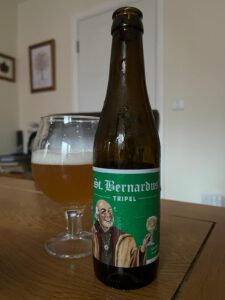
St. Bernardus Tripel (8%)
This one had a slightly maltier taste than the first two and was a little sweeter. A good Tripel.
Brewer’s note: St.Bernardus Tripel is a traditional abbey beer that follows the classic tripel style. In the Watou region a tripel is often referred to as a ‘Bernadetje’. A fine tribute that pays homage to Bernadette, the youngest daughter of Evariste Deconinck, the man to whom the monks of Abbaye Sainte Marie du Mont des Cats sold their Belgian property in 1934. St.Bernardus Tripel has a slightly sweet aroma and a flowery, fruity taste in which bitter and sweet merge harmoniously. Thanks to its pleasant hoppiness, the mouth feel of this beer is nothing short of beatific – it quenches your thirst and stimulates the appetite and this is what we call a perfect combination. A hugely accessible beer that is surprisingly light in character.
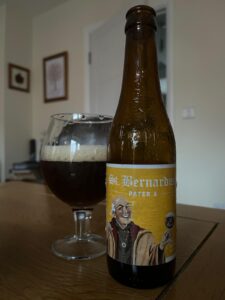
St. Bernardus Pater 6 (6.7%)
The aroma was more malty with hints of dried fruits. The flavour had a roastiness to it – similar to a porter. It felt quite light – maybe because we went down in ABV from the Tripel. Not as sweet as the Rochefort 6.
Brewer’s note: St.Bernardus Pater 6 is brewed according to the classic dubbel style with a recipe that dates back to 1946. The name of this beer has become a reference for its style, and it is commonly referred to as ‘een Paterke’. This Paterke is not just any old brown beer: it unites the deep flavour of specialty malt with the lively fruitiness of ripe tree fruits. Impressions of hazelnut and mocha lie at the basis of the mouth feel, which flows into an excellent yet playful duel between the mild taste of dark candy sugar and a slightly toasted but dry grain character. Plenty of apple and pear aromas make their magnificent presence felt all the way to the slightly bitter aftertaste.
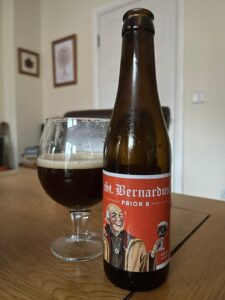
St. Bernardus Prior 8 (8%)
This one had a similar aroma to the 6, but taste-wise it was slightly sweeter and thicker, with a longer finish. It had a nice roastiness with maybe a hint of chocolate.
Brewer’s note: St.Bernardus Prior 8 is a traditional abbey beer, brewed in the classic dubbel style. The original recipe dates back to the times when we still brewed under licence (1946-1992). Named ‘World’s Best Dark Belgian Style Dubbel’ on the World Beer Awards, in other words, the best Dubbel beer in the world. St.Bernardus Prior 8 stands out with its fruity aroma, reminiscent of tree fruits like red apples, but complemented by exotic touches of figs and dates. The whole is rounded off perfectly by impressions of caramel and roast malt. The full taste is malty and fruity in equal measure and achieves the perfect balance between bitter and sweet.
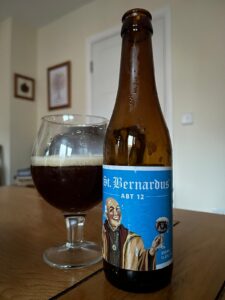
St. Bernardus ABT 12 (10%)
This is still up there as one of the best beers we’ve ever tried and was our favourite beer of the night. If you’re only going to try one St. Bernardus beer, make it this one.
Brewer’s note: St.Bernardus Abt 12 is widely regarded as one of the best beers in the world. It is therefore no surprise that it is our brewery’s flagship beer, ranked at the very top of the St.Bernardus beer hierarchy. It is brewed in the classic quadrupel style and adheres to the original 1946 recipe. St.Bernardus Abt 12 has a very fruity aroma that is the result of using our own unique yeast. It brims over with different, complex tastes and stands out through its long, bittersweet finish. Thanks to its mild, rounded taste and perfect balance between bitter and sweet, this beer goes down very easily. When you drink an Abt you can enjoy life to the full!
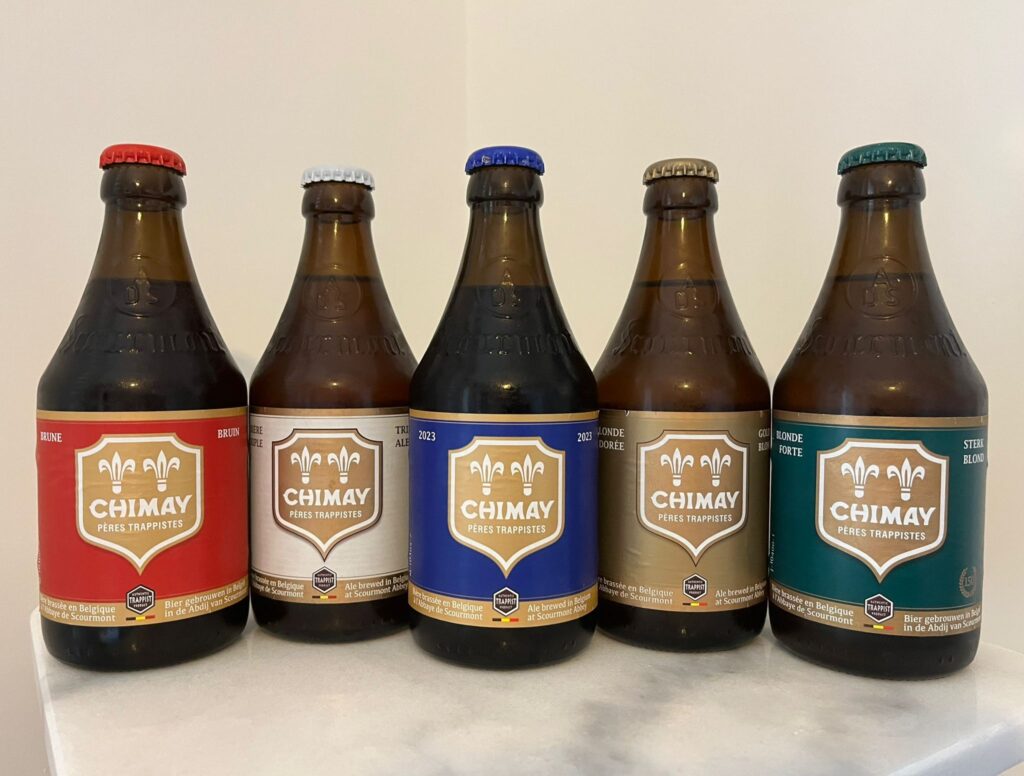
Chimay
Chimay is another of the Trappist breweries located in Belgium. They brew six beers – the five pictured here, plus a Grand Reserve, which is a barrel-aged brew.
We tried these in one evening, starting with the blondes in order of ABV (gold, white, green) and finishing with the darker beers in order of ABV (red, blue).
The only one we’d tried previously was the white and, while it was a good tripel, we didn’t love it. In this session, it was our least favourite of the Chimay beers – it had the most bitterness on the finish. The blue was our beer of the night and made it into our top five for the month of October.
Brewer’s website: Bières et Fromages de Chimay
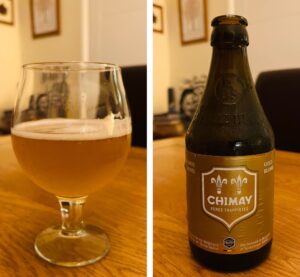
Gold: 4.8%
A strong start to the night. Despite its low abv, this was a lovely beer. Light, with citrus notes. A little thin for a blond (probably due to the low abv), but still full of flavour.
Brewer’s note: As its name suggests, Chimay Gold has an intense and appealing golden hue, with a tight, creamy head. Its aromas combine a wide range of fresh spicy and floral notes with an emphasis on citrus and fiery clove. Its flavour is well rounded with a deliciously sweet mouth feel and a perfectly balanced bitter taste. The lower alcohol content of Chimay Gold does nothing to diminish its flavour, distinguished by an exhilarating smell of refreshing coriander and refined hop. Its spicy flavour lingers well into the light dry aftertaste as the perfect conclusion to this elevated tasting experience.
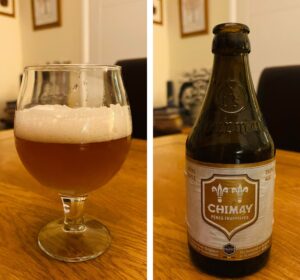
Triple: 8%
The only one we’ve tried before and we agreed with our original notes that it was a little too bitter on the finish. It had a thicker mouthfeel than the gold, but we both preferred the gold.
Brewer’s note: Chimay Triple has an appealing golden hue majestically crowned by an imposing white head. Its smell immediately reveals the deep complexity of this beer. Its rich fruity taste strikes a harmonious balance with floral notes and elegant nuances of spices thanks to yeast with a strong character. A subtle smoky aroma with a hint of vanilla form a pleasant contrast with the sweet malt. Its flavour is just as sensational, with its velvety mouth feel perfectly counterbalanced by just the right amount of bitterness from the hop. Orange peel and red apple deliver a refined aftertaste.
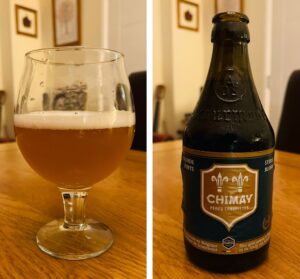
150: 10%
This had a slightly sweeter smell than the other two blonds and was different in flavour. It was boozy, a little creamy, and not as bitter. It also left a tingling feeling in your mouth – almost like menthol.
Brewer’s note: Chimay 150 is a strong, blond beer that is refreshing and fruity, tasty and intense. Its mint, bergamot, lime and eucalyptus aromas will take you on a surprising journey. Its delicate hints of rosemary and clove go perfectly with the subtle floral notes, enhanced by a touch of invigorating ginger. Its mellow, rounded body and smoky, spicy flavour are typical of Chimay beers, and will leave you with an exquisitely sophisticated aftertaste.
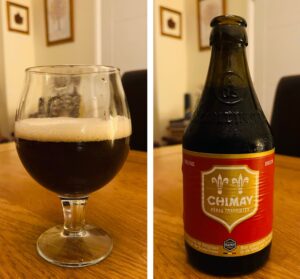
Red: 7%
We both tend to favour dark Belgian beers over blond Belgian beers, and this one was very good. It had a subtle roastiness, with notes of caramel and a quick finish.
Brewer’s note: It’s beautiful brown colour is awash with hues ranging from smoldering copper to deep ruby. It’s balanced blend of generous fruity flavours and toffee pleases every palate. A succession of ripe fruits such as orange, peach and apricot is paired exquisitely with sweet malty flavours such as nougat and biscuit. Its refreshing minerality and smooth bitterness complete the palette of flavours. The delightful pairing of aromas and flavours lingers well into the aftertaste and leaves the mouth eagerly anticipating the next sip.
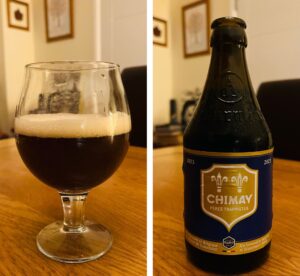
Blue: 9%
This was our favourite beer of the night. It had flavours of dried fruit and a lovely long finish. A great beer to finish on.
Brewer’s note: The beautiful warm, dark hues of Chimay Blue and its compact light-brown head put on a spectacular show. This beer is without a shadow of a doubt a match made in heaven between luscious fruity aromas and delicious chocolate. It begins with a light sweet note before the creamy caramel transitions to a soft Mocha combined with an intense spicy taste, culminating in a delicious candied fruit finish. The delicious overall flavour develops into a pleasant lingering aftertaste, triggering a subtle warm feeling and the sensation of pure chocolate.
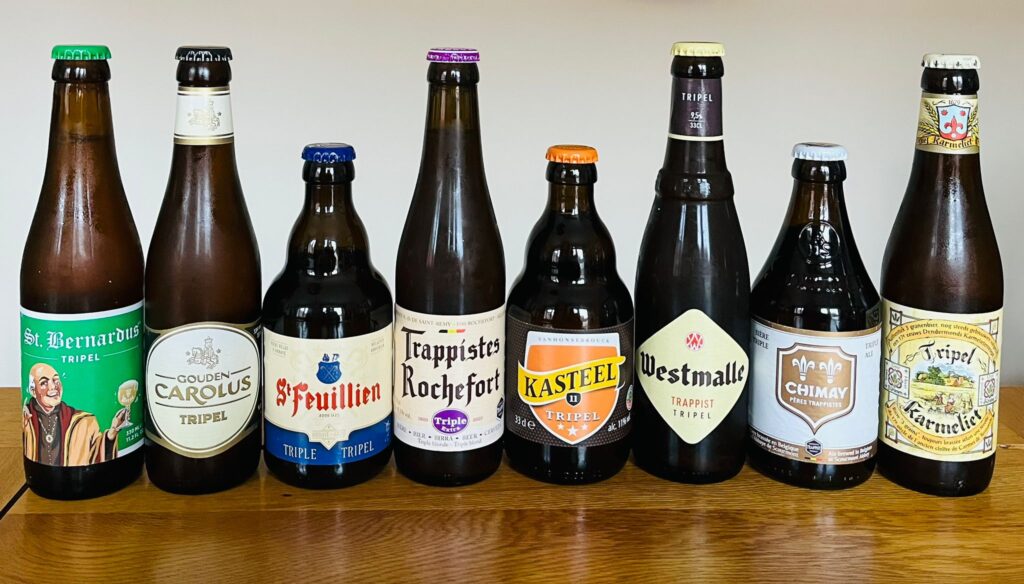
Battle of the Tripels
We’ve tried various Tripels in our beer battles so we decided to see which came out on top. Our Tripel battle included four we’d tried before and four new ones.
Tripels are pretty strong so we battled these over two nights. Night one, we tried St. Bernardus, Gouden Carolus, St. Feuillien, and the Chimay. Night two, we tried the Trappistes Rochefort, Kasteel, Westmalle and Tripel Karmeliet.
We poured all four and directly compared them (Alex tasted them all without knowing which was which so he could give objective opinions).
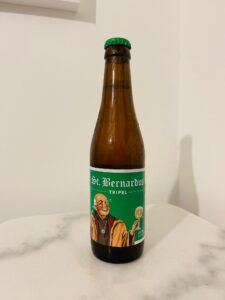
St. Bernardus Tripel 8%
We’ve tried all the core St. Bernardus beers and have enjoyed them – in particular the Abt 12 and the Christmas Ale – so this was our second tasting of the Tripel. It had the sweetest aroma of the four we tried on night one with lovely vanilla scents. It was the thinnest of the four and the fizziest, but it tasted delicious.
Brewer’s note: St.Bernardus Tripel is a traditional abbey beer that follows the classic tripel style. In the Watou region a tripel is often referred to as a ‘Bernadetje’. A fine tribute that pays homage to Bernadette, the youngest daughter of Evariste Deconinck, the man to whom the monks of Abbaye Sainte Marie du Mont des Cats sold their Belgian property in 1934. St.Bernardus Tripel has a slightly sweet aroma and a flowery, fruity taste in which bitter and sweet merge harmoniously. Thanks to its pleasant hoppiness, the mouth feel of this beer is nothing short of beatific – it quenches your thirst and stimulates the appetite and this is what we call a perfect combination. A hugely accessible beer that is surprisingly light in character.
Brewer’s website: Home | St.Bernardus (sintbernardus.be)
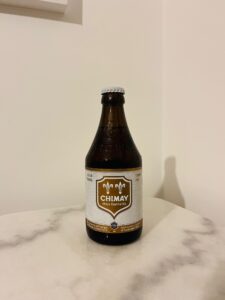
Chimay Triple 8%
We’ve tried the Chimay triple twice – once in our oiriginal 2023 battle and once in our recent Chimay battle. Of the four we tried on night one, it had the nicest mouthfeel and a lovely aroma. It is a good triple, but we both the finish a little too bitter for our tastes.
Brewer’s note: Chimay Triple has an appealing golden hue majestically crowned by an imposing white head. Its smell immediately reveals the deep complexity of this beer. Its rich fruity taste strikes a harmonious balance with floral notes and elegant nuances of spices thanks to yeast with a strong character. A subtle smoky aroma with a hint of vanilla form a pleasant contrast with the sweet malt. Its flavour is just as sensational, with its velvety mouth feel perfectly counterbalanced by just the right amount of bitterness from the hop. Orange peel and red apple deliver a refined aftertaste.
Brewer’s website:Bières et Fromages de Chimay
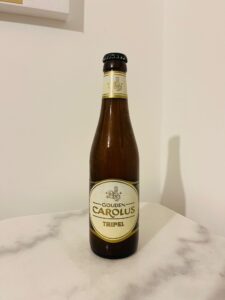
Gouden Carolus Tripel
We tried the Gouden Carolus classic during our visit to Belgium, but this was the forst time we tried their tripel. It had a great head and a peppery, spicy aroma that wasn’t as sweet as the others on night one. It had a good body and good flavour. Not as sweet as some of the others, and quite peppery, but the pepperiness wasn’t too overpowering.
Brewer’s note: Despite technological advancements, this beer is brewed following centuries-old traditions, combining, as in the past, the finest ingredients from our soil, such as ripe barley and fine hops, to preserve as much pure aroma as possible. Originally brewed for the Knights of the Golden Fleece in 1491, this beer is full of graceful tenderness, with a clean and refined taste that is sure to charm you. Bottle-aged, crafted exclusively from pale malt, top-fermented, and 100% natural.
Brewer’s website: Brewery and Distillery Het Anker
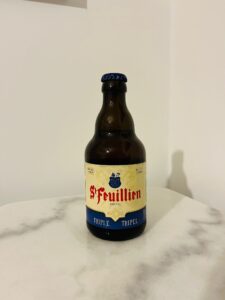
St. Feuillien 8.5%
Another new brew and this one had a lovely aroma and the nicest mouthfeel of the first four. The flavours were very good, but dissipated a bit too quickly which was a shame.
Brewer’s notes: This beer has a white, smooth, and very compact head. Its pale amber color is very characteristic revealing a distinctive maltiness. It has a rich aroma with a unique combination of aromatic hops, spices, and the typical bouquet of fermentation – very fruity. Secondary fermentation in the bottle gives it a unique aroma due to the presence of yeast. St-Feuillien Triple has a robust and exceptionally lingering taste thanks to its density and long storage period. Whether served as a refreshing aperitif in summer or savored during the winter months, the Triple is a connoisseur’s beer par excellence.
Brewer’s website: Brasserie St-Feuillien
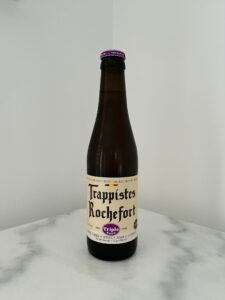
Trappistes Rochefort
We tried three Trappistes Rochefort beers earlier in the year, but this was our first time trying the Triple. It had a lot of orangey aromas and flavours similar to orange cordial. It was a nice beer, but very different to the others and not really what we’d expect from a triple.
Brewer’s note: Highly anticipated by consumers, Triple Extra is the only lager in the range, and the most recent addition to the family, introduced in 2020. The recipe is inspired by an extra-strong lager brewed 100 years earlier. It is pale gold in colour, with a dense white head. Best served between 6 and 9°C, it releases subtle citrus and hoppy aromas and complex floral flavours, as well as being deliciously smooth. The purple colour associated with it is the colour of friendship: a colour that suits it perfectly since Triple Extra draught beer is a light, fruity beer to be shared amongst friends. With its intense freshness and golden blond colour evoking the sun, it is also the ideal beer to enjoy on a terrace in the summer.
Brewer’s website: Trappistes Rochefort
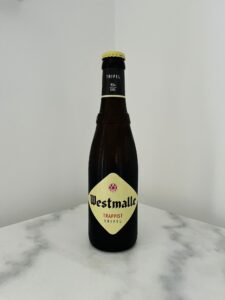
Westmalle Tripel 9.5%
This was our third time trying the Westmalle Tripel. It’s a great example of the style, so if you aren’t familiar with Tripels, we’d recommend trying this one to get a taste of what to expect. It has a good mouthfeel and a lovely lingering flavour. This was Alex’s beer of the night and favourite of the eight.
Brewer’s note: Was first brewed in 1934 and the recipe has not changed since 1956. It is made with pale candy sugar and has a very pale color produced from a mash of light pilsener malts. Styrian Goldings hops are used along with some German varieties and the classic Saaz pilsener hop. After a long secondary fermentation, the Tripel Westmalle is bottled with a dose of sugar and yeast. This beer holds up well in the bottle over time and seems to soften with age.
Brewer’s website: Trappist Westmalle | Abbey of the Trappists Westmalle
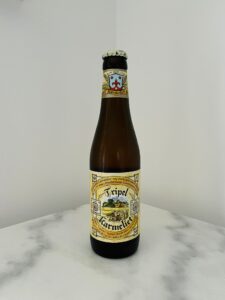
Tripel Karmeliet 8.4%
We’ve tried Tripel Kartmeliet at home in bottles and in Belgium on draft and it’s one of our highest scoring Tripels. As was the case the first time we tried it, it got better and better as it warmed up. And although Westmalle was my favourite on the first taste, this one ended up being my beer of the night and my favourite of the eight.
Brewer’s note: For over seven generations, we have shared a relentless dedication to brewing excellence, perfecting our craft to create the beer you love. Brewed using the 3-grain recipe we inherited, our beer is the result of a skillful combination of barley, wheat, and oats. Barley provides the flavour, colour, and body, while wheat gives our beer its lightness of body, and a subtle aroma of freshly baked white bread. Finally, oats bring a creamy mouth-feel and silky finish to achieve the perfect balance you only find in a glass of Tripel Karmeliet.
Brewer’s website: Home | Tripel Karmeliet
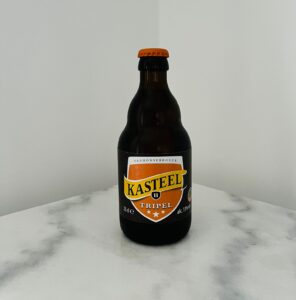
Kasteel Tripel 11%
We’ve previously tried the Kasteel Rouge, but not the Tripel so this was another new brew and a fantastic beer. It had a thick mouthfeel and lots of flavour (but it was also the highest ABV so that’s maybe why). Although it had quite a lot of pepperiness and bitterness, it was really well structured so it wasn’t too overpowering.
Brewer’s note: Kasteel Tripel is a bottle refermented, clear honey-coloured beer. On the nose, we are met by aromas of banana and clove. The carefully selected aroma hops give the beer a mild bitterness, complemented by fresh fruity notes. The warming mouthfeel and slight spicy finish, where the high alcohol content becomes most pronounced, rounds off the flavour profile.
Brewer’s website: Vanhonsebrouck

